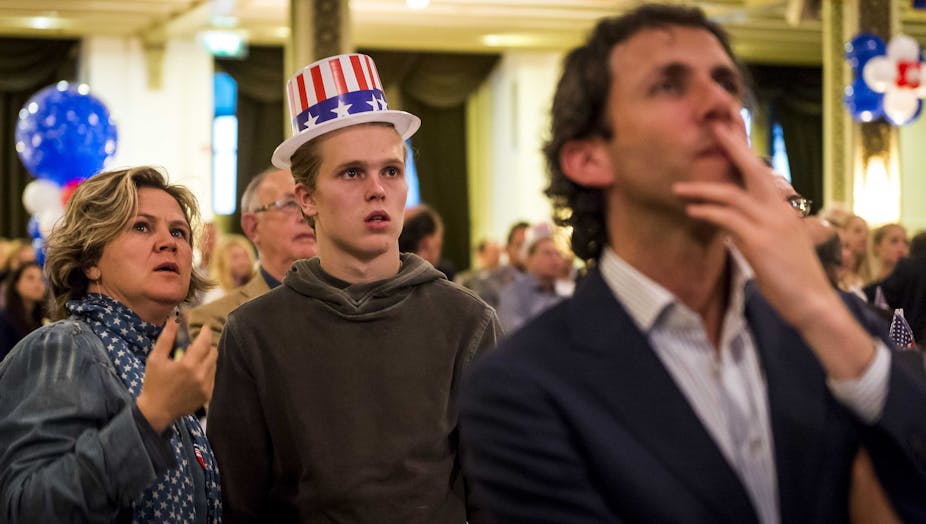Since records began in 1868, no clear favourite for the White House has lost, except in the case of the 1948 election, when 8 to 1 longshot Harry Truman defeated his Republican rival, Thomas Dewey.
We can now add 2016 to that list, thanks to Donald Trump, who has beaten 5 to 1 on favourite, Hillary Clinton, to take the presidency. In so doing, he also defied the polls, the experts and the wisdom of crowds.
I have been tracking various forecasting methodologies and prognosticators over the past few months, right up to election day, and can confirm that the rout of conventional wisdom was almost total.
Odds on
On the morning of the election, the best price available about Hillary Clinton was 7 to 2 on, equal to an implied win probability of about 78%. The spread betting markets made her a little over an 80% favourite, and gave her a head start over Trump of more than 80 electoral votes. The PredictIt prediction market assigned her a 79% chance of victory, and estimated her likely advantage as 323 electoral votes to 215 for Trump. Meanwhile, the Predictwise crowd wisdom platform assessed her chance of winning at a solid 89%, compared to 75% by the Hypermind prediction site.
The polling aggregation services fared no better. The RealClearPolitics and HuffPost Pollster polling averages gave Hillary Clinton a lead of between 3% and 6%. The FiveThirtyEight platform, which removes bias from polls based on their previous performance, gave her a popular vote lead on the day of 3.6% and an electoral vote advantage of 67 over Trump. Her chance of winning was assessed as 71.9% based on this polling.
Perhaps the biggest failure of the night, however, was Sam Wang’s Princeton Election Consortium, which gave Clinton more than a 99% chance of victory. Still, it must be said that his topline figures (an electoral college advantage of 307 to 231 for Clinton, and 2.5% in the popular vote) were less far off than a number of the other forecasting methodologies.
The New York Times Upshot elections model, which bases its estimates on state and national polls, gave Clinton a 84% chance of victory, which they helpfully compared to the chance of an NFL kicker making a 38-yard field goal. About 16% of the time they miss. That was the same chance as Hillary Clinton losing, they suggested.
Talking heads
Expert opinion was also woefully off. One of the most high-profile providers of expert political opinion is the Sabato Crystal Ball, run by Larry Sabato of the University of Virginia’s Center for Politics. This service has a very good track record. Yet, in line with the polls and the markets, the Crystal Ball got it badly wrong this time. Its final prediction was a win for Hillary Clinton by 322 electoral votes to 216.
It is the PollyVote election forecasting service which provides perhaps the most broad-based expert opinion survey, however, calling on its own panel of political experts to periodically update its forecast of the likely two-way vote share of the main candidates. The final expert panel survey, conducted on the eve of the election, put Clinton 4.4% up over Trump (52.2% to 47.8%).
In attempting to estimate the final vote share tallies of the candidates, PollyVote provides not just the estimates of experts, but also evidence gathered from a range of other methodologies, including prediction markets, poll aggregators, econometric models, citizen forecasts and index models. The idea is that aggregating and combining the wisdom of each and taking an average should provide a better estimate than any in isolation. It is a methodology which has served well over the past three election cycles.

This time the methodology broke down as badly as any of the main forecasting methodologies in isolation. Taking them in turn, the prediction market indicator (based on the trading in the Iowa electronic markets) gave Hillary Clinton a lead of 54.6% to 45.4%. Using data from RealClearPolitics and HuffPost Pollster to construct its poll aggregation metric, it gave the lead to Clinton by 52% to 48%.
PollyVote also highlights the various econometric forecasting models available, which typically use variables such as growth, unemployment, incumbency, and so on, to provide an aggregated estimate. That estimate was, this time, quite successful, giving Clinton the advantage in the popular vote of 50.2% to 49.8%. Winning the popular vote is, however, not the same thing as winning the electoral college, as Democrats in particular have learned in recent years.
The final two methodologies used to make up the PollyVote forecast are index models, which use information about the candidates, and citizen forecasts, which ask people whom they expect to win. The index models this time gave Clinton the edge over trump by 53.5% to 46.5%, and the citizen forecasts by 52.2% to 47.8%. Combining all these methodologies together produced an estimated advantage for Clinton over Trump of 52.5% to 47.5%.
The bottom line, therefore, is that most of the tried and tested forecasting methodologies failed this time. Election 2016 truly demonstrated, on a grand scale, the madness of crowds, polls and experts.

